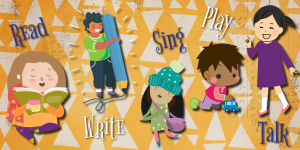
Many people argue that when parents speak their non-English home language to their children, it can be detrimental to English language acquisition. This idea is far from the truth!
Speaking to your child in your native language, or the language you are most comfortable in, does wonders for children's language development and acquisition, regardless of what language is being spoken. When parents and children share conversations in their native language, they experience greater levels of closeness and engagement with each other. Parents are able to provide richer vocabulary and description in their speech, giving children more tools to describe and relate to the world around them. This knowledge provides children with a great foundation for later English learning.
There are so many benefits to immersing your child in your native language. Language is an important piece of your family's culture and background; be proud to share it! And raising a bilingual or multilingual child has many invaluable impacts on a child's cognitive abilities and communication skills that will last a lifetime.
Here are some ideas on how to integrate your native language into your home:
Babies
- Start young! Babies are the perfect age to learn a new language, because their brains are great at integrating new information.
- Make conversation with your baby. Your baby loves making conversation with you, even if they can’t respond in words yet. Listen to your child while they talk to you, and answer them back. You can describe things you do together, like driving in the car or changing a diaper to give them descriptions of the world around them.
- Sing to your child. Sharing nursery rhymes and lullabies in your native language is a great way to introduce language to your child. These can also be bonding experiences to help baby feel close to you.
Toddlers
- Give your toddler choices. Asking your toddler to choose between things will give them experience with communicating and new vocabulary.
- Share stories in two languages. Find resources to share with your child in your home language and English. These stories can help introduce your child to English words while still providing them the comfort of your home language. Your local library is a great place to look for resources like this.
Preschoolers
- If your child makes mistakes, correct them gently. Sometimes bilingual children can get confused between their home language and English, especially if they are learning them concurrently. When your child makes a mistake, simply repeat back what they said the correct way. Some children may code switch, or alternate between both languages, especially if they feel more comfortable using certain words in certain languages. This is perfectly okay, because it shows that your child is actively using their language abilities!
- Help provide more descriptors to your child. Introduce your child to descriptive words that will richen their vocabulary. For example, you can broaden their idea of “foods” by integrating descriptors like “warm,” “spicy,” “cold,” “sweet,” “sour, “ etc.
-Mandy, Children's Team, Martha Cooper Library
Resources:
Kester, Ellen. "Should I Stop Speaking my Native Language with my Children?" Bilinguistics.
"Tips for talking to your baby and young child." National Literacy Trust, 2017.
"Why talking to your baby or child matters." first five years, 2019.
 Read, Write, Talk, Sing, Play!
Read, Write, Talk, Sing, Play!
The day children are born, their brains are primed for language. Talking with your child about anything and everything helps them build oral language skills, which are critical to early literacy!
Read more about early literacy and how you can make a difference in your child's life.

